
Huntsman spiders, members of the family Sparassidae, are known by this name because of their speed and mode of hunting. They are also called giant crab spiders because of their size and appearance. Larger species sometimes are referred to as wood spiders, because of their preference for woody places. In southern Africa the genus Palystes are known as rain spiders or lizard-eating spiders. Commonly they are confused with baboon spiders from the Mygalomorphae infraorder, which are not closely related.
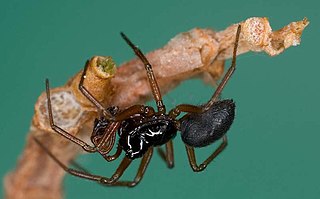
Erigoninae are the largest subfamily of sheet weavers (Linyphiidae), which is itself the second largest spider family. In the United States they are known as dwarf spiders, while they are called money spiders in England. The exact taxonomic limits of the subfamily are not yet known.

Lampshade spiders, family Hypochilidae, are among the most primitive of araneomorph spiders. There are two genera and twelve species currently recognized. Like mygalomorphs, most hypochilids have two pairs of book lungs, but like araneomorphs they have intersecting fangs, with the exception of some species which have chelicerae in an angle that is neither orthognathous or labidognathous. These long-legged spiders build typical "lampshade" style webs under overhangs and in caves. In the United States the fauna is primarily associated with the Appalachian, Rocky and California Mountains. Ten of the known species are found in these ranges, all in the genus Hypochilus. The genus Ectatosticta is found in China.
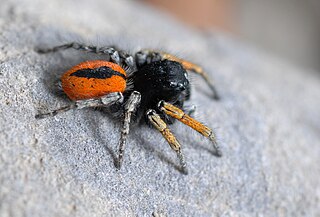
Philaeus chrysops is a species of jumping spider (Salticidae).
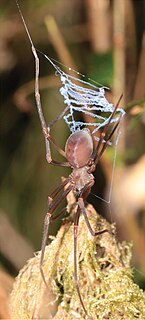
Cribellum literally means "little sieve", and in biology the term generally applies to anatomical structures in the form of tiny perforated plates.

Periegops is a genus of spiders with six eyes instead of the usual eight. It is the only genus in its family (Periegopidae) and has three described species. It was long considered to be members of Sicariidae or Segestriidae until Raymond Forster elevated them to the family level in 1995.

Cyatholipidae is a family of spiders first described by Eugène Simon in 1894. Most live in moist montane forest, though several species, including Scharffia rossi, live in dry savannah regions. They occur in Africa, including Madagascar, New Zealand and Australia, and one species in Jamaica. Most members of this family hang beneath sheet webs. Fossil species occur in the Eocene aged Bitterfield and Baltic Ambers, suggesting a wider geographic distribution in the past.
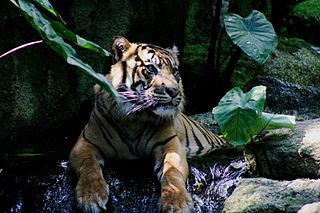
The fauna of Indonesia is characterised by high levels of biodiversity and endemicity due to its distribution over a vast tropical archipelago. Indonesia divides into two ecological regions; western Indonesia which is more influenced by Asian fauna, and the east which is more influenced by Australasian species.

The wildlife of Tunisia is composed of its flora and fauna. It has 84 species of mammals and 375 species of birds. Tunisia is well documented for its addax and Dama Gazelle population.

The great raft spider or fen raft spider is a European species of spider in the family Pisauridae. Like other Dolomedes spiders, it is semiaquatic, hunting its prey on the surface of water. It occurs mainly in neutral to alkaline, unpolluted water of fens and grazing marsh.

Yule Island is a small island in Central Province, Papua New Guinea. It is located 160 km NW from Port Moresby, on the south coast of Papua New Guinea.
Wildlife of Sri Lanka includes its flora and fauna and their natural habitats. Sri Lanka has one of the highest rates of biological endemism in the world.
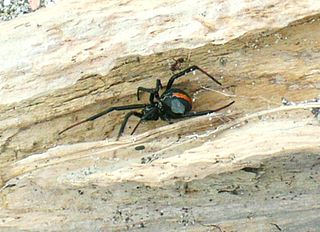
New Zealand has 1134 described spider species, with an estimated total fauna of 2000 species. Over 90 per cent are endemic, and the rest have been introduced through human activities or were natural wind-borne introductions.
The Kaijende Highlands are a nearly uninhabited expanse of mountains near Porgera in Enga Province, Papua New Guinea. The highlands have been characterized as "some of Papua New Guinea's most pristine and scenic montane habitat". The Kaijende Highlands include Lake Tawa, Paiela Road, Omyaka Creek, Waile Creek and the Porgera Reservoir. The mountain range is 70 km north-west of Mount Hagen. According to a survey conducted in 2007, "areas like Kaijende are characterized by pronounced dominance of microtherm families, most notably by Cunoniaceae, Epacridaceae, Ericaceae, Geraniaceae, Myrsinaceae, Podocarpaceae, Ranunculaceae, Rosaceae, Theaceae, Violaceae, and Winteraceae."

Caponiidae is a family of ecribellate haplogyne spiders that are unusual in a number of ways. They differ from other spiders in lacking book lungs and having the posterior median spinnerets anteriorly displaced to form a transverse row with the anterior lateral spinnerets. Most species have only two eyes, which is also unusual among spiders. A few species of Caponiidae variously have four, six or eight eyes. In some species the number of eyes will increase when the spiderling changes its skin as it grows towards adulthood.
Nusoncus is a monotypic genus of dwarf spiders containing the single species, Nusoncus nasutus. It was first described by J. Wunderlich in 2008. It is considered new to the fauna of Latvia since 2009.

Clubiona subtilis is a spider species with Palearctic distribution. It is considered new to the fauna of Latvia since 2009.
Ozyptila gertschi is a crab spider species with Holarctic distribution. It is considered new to the fauna of Latvia since 2009.

Hyptiotes paradoxus is a spider species with Palearctic distribution. It is notably found in Lithuania and Latvia. It is also found in Estonia and Finland.















